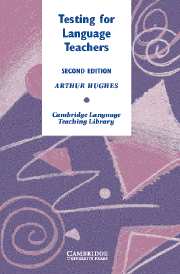Book contents
- Frontmatter
- Contents
- Acknowledgements
- Preface
- 1 Teaching and testing
- 2 Testing as problem solving: an overview of the book
- 3 Kinds of tests and testing
- 4 Validity
- 5 Reliability
- 6 Achieving beneficial backwash
- 7 Stages of test development
- 8 Common test techniques
- 9 Testing writing
- 10 Testing oral ability
- 11 Testing reading
- 12 Testing listening
- 13 Testing grammar and vocabulary
- 14 Testing overall ability
- 15 Tests for young learners
- 16 Test administration
- Appendix 1 The statistical analysis of test data
- Appendix 2 Item banking
- Appendix 3 Questions on the New Zealand youth hostels passage
- Bibliography
- Subject Index
- Author Index
- Frontmatter
- Contents
- Acknowledgements
- Preface
- 1 Teaching and testing
- 2 Testing as problem solving: an overview of the book
- 3 Kinds of tests and testing
- 4 Validity
- 5 Reliability
- 6 Achieving beneficial backwash
- 7 Stages of test development
- 8 Common test techniques
- 9 Testing writing
- 10 Testing oral ability
- 11 Testing reading
- 12 Testing listening
- 13 Testing grammar and vocabulary
- 14 Testing overall ability
- 15 Tests for young learners
- 16 Test administration
- Appendix 1 The statistical analysis of test data
- Appendix 2 Item banking
- Appendix 3 Questions on the New Zealand youth hostels passage
- Bibliography
- Subject Index
- Author Index
Summary
We will make the assumption in this chapter that the best way to test people's writing ability is to get them to write. This is not an unreasonable assumption. Even professional testing institutions are unable to construct indirect tests that measure writing ability accurately (see Further reading; Godshalk et al.). And if, in fact, satisfactory accuracy were a real possibility, considerations of backwash and ease of construction would still argue for the direct testing of writing within teaching institutions.
Given the decision to test writing ability directly, we are in a position to state the testing problem, in a general form, for writing. This has three parts:
We have to set writing tasks that are properly representative of the population of tasks that we should expect the students to be able to perform.
The tasks should elicit valid samples of writing (i.e. which truly represent the students' ability).
It is essential that the samples of writing can and will be scored validly and reliably.
We shall deal with each of these in turn, offering advice and examples.
Representative tasks
Specify all possible content
In order to judge whether the tasks we set are representative of the tasks that we expect students to be able to perform, we have to be clear at the outset just what these tasks are that they should be able to perform.
- Type
- Chapter
- Information
- Testing for Language Teachers , pp. 83 - 112Publisher: Cambridge University PressPrint publication year: 2002



